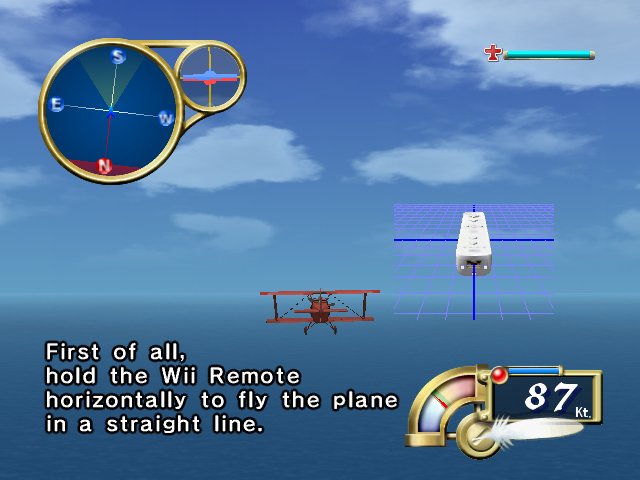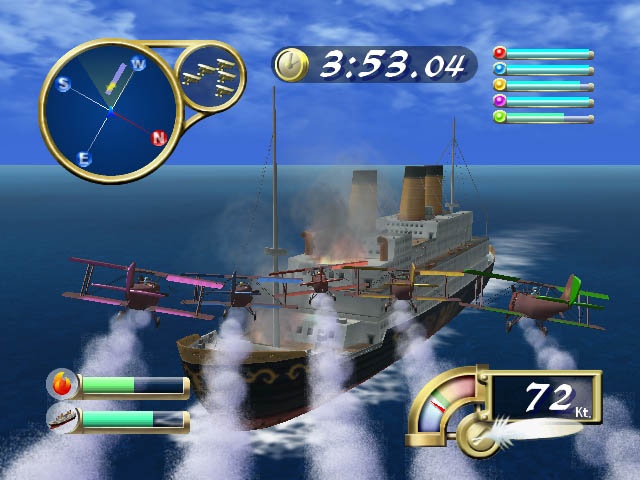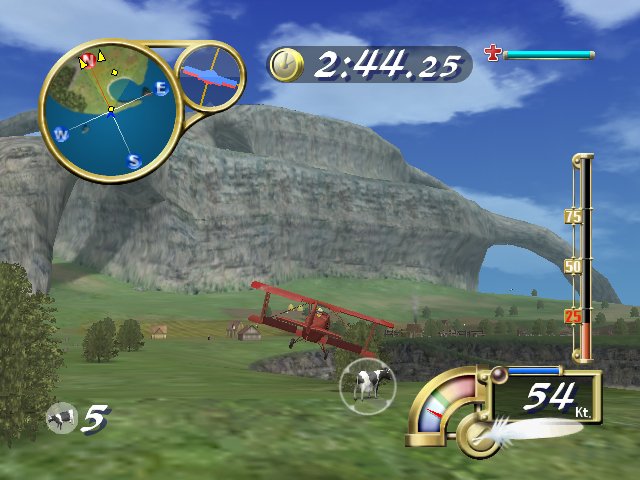Casual games are big business, and they're certainly an area Nintendo is looking to expand into with its made-for-everyone Wii. Developed by Hudson, best known for its Bomberman and Mario Party line of games, Wing Island has that crowd in its crosshairs. Unfortunately, it forgot to put ammunition in its guns and equip the guns to the plane, which itself is too slow to make a difference anyway. Really, it seems like Wing Island is just pointing a crosshair, hoping its target will come crashing into it.

For a game in which human-sized sparrows spurn their natural wings for mechanical ones, Wing Island comes up empty on the charm. You play as Junior, a young sparrow pilot, and after your gramps' gypsy blood gets the better of him, you're left in charge of the family handyman business. Assisting you is your longtime friend and mechanical ace Puffin, who isn't unlike a female Slippy Toad of Star Fox fame, which is to say she's painfully annoying. Each mission is prefaced with Puffin coming to you in a huff, relating the desperate situation that requires your immediate attention. Playful banter or ridiculous situations that could have been incorporated to liven things up are nowhere to be found, so you're relegated to canvassing the island for a little kid's lost cows or aiding Fireman Gull in putting out forest fires. It's all pretty rote, and it would quite possibly be one of the worst conceits for a game in recent history if it weren't for the Wii's magical motion-sensing remote.
The crux of the Wing Island experience rests with the Wii Remote. Rather than mimicking a yoke or flight stick, you'll simply hold the Wii Remote like a regular TV remote and then guide your plane in as straightforward of a way as possible. If you move the remote up, you go up; down down; left left; and right right. Swiping the remote in one direction or another results in a hairpin turn, thrusting forward gives you a speed boost, and tugging backward activates the air brakes. Occasionally, a hairpin turn will be confused for a thrust, and for whatever reason, your plane will frequently throttle down. This forces you to constantly press up on the D pad, but for the most part, the basics are sound, if a bit unimaginative.
Unfortunately, during two-thirds to three-quarters of the game you're flying in a squadron, and this is where the formula breaks down. There are three different formations: a balanced flying V, a speedy straight line, and a maneuverable iron cross. You'll frequently need to switch between these formations to maximize your time or effectiveness in the missions. The problem is that the motion required for switching these formations is too similar to the motions for turning, speeding up, and slowing down. So you'll frequently be at war with the controls to get your lineup in the proper formation and moving in the proper direction. The situation improves once you figure out that you can double-tap the A button to cycle through the formations, but even then, it still feels like you're controlling the planes with marionette wires rather than from the cockpit.

For being an uneducated farmhand or a Podunk fireman, denizens of Shell Island certainly pay well for your services. But before they fork over the money, they're going to request the job be done--and done well. Missions are timed, and how much time remains, as well as how efficiently you hit your marks, factors in heavily to your overall grade. Even after you've come to terms with the clunky and unsatisfying control scheme, you'll have to perform near flawlessly to see any money. It's quite common to finish a mission with 30 seconds out of three minutes remaining and for whatever reason be awarded only five out of 100 points, which nets you nothing other than opening up the next mission. The mundane mission designs are more of an exercise in patience than flight skill and will have you inadvertently, then purposefully, throttling into the mountains or nose-diving into farmhouses. For the record, birds can't get caught in your propellers, and any other destructive urges that may arise within you will have little effect on the environment.
Wing Island is one of those games where you beat your head against a mission repeatedly until some unknown force manifests and you perform perfectly. So money will eventually find its way to Junior's pocket, and because Shell Island's entertainment industry isn't exactly booming, you'll have to funnel that cash back into the family business. Each of your planes can be upgraded with better turning, increased power, or decreased weight, which can then be upgraded five times at an escalating cost. As you careen into bluff mountain walls or nosedive into placid waters, your plane will take damage, and the amount of total damage you can withstand before exploding decreases the longer you go without making repairs. Luckily, repairs are relatively cheap, so fixing your busted jalopy is not really an issue.
It's no wonder Gramps needed a vacation, because there really isn't much to catch your eye while flying around the two islands in the game. Occupying that unhappy nebulous zone between realistic and cartoony, Wing Island looks substandard even by Wii expectations. Your airplanes are typically a single, solid color; mountain textures are bland and nondescript; the ocean looks like a flat sheet of aquamarine; the clouds in the sky are static; and there isn't much sign of wildlife except for the occasional flock of seagulls or the aforementioned wayward bovine. Aliasing runs rampant as well, creating a jagged effect on darn near everything. Topping things off, the frame rate chugs when you fly by one of the game's few flourishes, which is a waterfall on the second island. Asking for Flight Simulator-level detail is out of the question, so this game really needed some kind of zany touch to help it transcend the Nintendo 64-comparable realism on display.
The audio is equally uninspiring. Instead of voiced dialogue, there's a Morse code-sounding blip noise that sounds off as the text scrolls onscreen. Your airplanes' engines would sound more appropriate strapped to a lawnmower, and that's true for every plane you lash yourself into, whether it's a zippy biplane or a hulking cargo transport. There aren't any ambient sounds, and bouncing off a mountain wall or hitting the ocean is accompanied by a hollow, tinny crash noise coming out of the remote's speaker. Wing Island's soundtrack is at least decent, if not particularly remarkable.

Wing Island does offer a multiplayer mode, which consists of a few minigames. You and another player can go head-to-head in a few short checkpoint races, see who can pop the most floating balloons, or try to pop a trail of balloons affixed to the other player's craft. The balloon-trail minigame is the only one that's even remotely enjoyable, and it's pretty lame that only two players are supported for any of the minigames in this mode. Aside from that, there's a mode that lets you fly around the various islands without a time limit, and that's about it. These extras aren't all that great, and because there are only about 20 missions in the story mode, you should be done with Wing Island pretty quickly. At least the game is marked down to $40.
Wing Island seems to be a casual airplane game designed to get anyone and everyone flying using the motion-sensing Wii Remote. The precise controls on any standard gamepad would trivialize the flying experience found here, so struggling with the new control scheme seems to be the point of this game. That's just not fun however you slice it. Once you add in the bland visuals and frustrating, menial missions, Wing Island stalls before even leaving the tarmac.